INTRO:
When games on the computer platform had advanced to VGA graphics, the first few games which made use of them were adventure games which relied on pixel art. These games consequently received venerable status. Up till today, there is still a niche market for them, driven mainly by nostalgia. It so happens that Wadjet Eye Games, founded by Dave Gilbert (not related to Ron Gilbert in any way), is one of its proprietors.
Many of Wadjet Eye’s published games pay tribute to old works of fiction which were popular and/or had achieved cult classic status. Technobabylon, developed by Technocrat, is one of these. Its sources of inspiration include sci-fi stories, especially Blade Runner and fiction about the next form of mass communication. Underneath the sci-fi trappings, there is a story about the flaws and virtues of humanity which make Technobabylon’s story more grounded and believable.
PREMISE:
It is the year 2087. Although unbelievably advanced technology like flying cars and teleportation have yet to be prolific, progress has occurred such that the next form of mass communication, the Trance, has been implemented. Gene-manipulation is no longer taboo. An entire city can even be regulated by a centralized artificial intelligence.
Newton is one such city, where just about anything goes as long as it does not threaten the order of the city. However, despite its efficiency and culture of freedom, all is not well. There is a serial killer who steal the minds of his victims. There are many people who have an unhealthy obsession with the Trance. Gene-engineering has caused just as much harm as good, such as creating living human bombs.

It is in this setting that three protagonists are introduced: Latha Sesame, Max Lao and Charlie Regis. Latha is a near-hopeless Trance-addict, whereas Max Lao and Charlie Regis are official investigators who are partners, yet who are far apart in their values in matters not regarding law and order.
One day, a sequence of unexpected events would lead these three together to uncover a conspiracy that endangers the city. Regis would have to overcome his loss and Latha would learn a startling truth about herself. As for Max, she is there for lighter-hearted moments.
CHARLIE REGIS:
Charlie Regis is the main protagonist of the game; this is a fact that would become clearer when flashbacks and other plot expositions reveal his involvement in pivotal moments of Newton’s history.
The player is introduced to Regis when he is an operative of “CEL”, the intelligence and law enforcement arm of Newton’s government. Regis is hesitant in adopting transhuman technologies and other high technology of the physiologically invasive sort, hence preferring to use whatever tools he has on hand, his knowledge and his wit. In other words, Regis is the regular archetype of player characters in adventure games.
One of the knowledge bases which he has is mostly of relevance to the narrative, but it is barely used for gameplay and puzzle designs. At most, it is used as an excuse to set up challenges for one of Max Lao’s segments.
LATHA SESAME:
Latha’s surname was not inherited; it was assigned on a whim, as is the case for children who are raised through the city’s welfare programme. Unfortunately, Latha is one of the Trance’s many addicts. Long unemployed and lacking the will to find a job, Latha is very close to neglecting her health and hygiene altogether.
Yet, Latha can enter the Trance at any time – something that no one else can do easily. Gameplay-wise, the player will be using this ability of hers to solve problems in cyberspace in order to solve problems in real-space, and vice versa. This is just as well; when playing as Latha, observant players would be looking for anything that is remotely electronic and connected to the Internet, because chances are that they would be solving puzzles by making use of these.
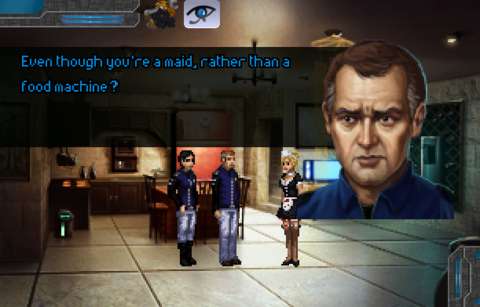
MAX LAO:
In terms of her technical designs as a player character, Max Lao is like an empowered version of Regis, thanks to her acceptance of high technology (specifically “wetware”). However, she lacks Latha’s Trance ability, despite canonically being capable of diving into the Trance.
After the player has finished the game, he/she might find that Max Lao’s contribution to the story is little more than as a partner to Regis. There is exposition on her past, but this appears to have only kitsch value. Perhaps it would be relevant in the sequel, but that is another story.
DIVERSE CAST FOR THE SETTING:
As to be expected of a game that is published by Wadjet Eye, it has a variety of characters. Most of them are implemented in order to flesh out the setting, especially Newton City’s incredibly free culture. Players can expect homosexual characters, transgenders, android/gynoid fetishists, and religious drug peddlers, among others. If they are not there to represent such themes, they would speak of what were once taboo, such as cloning, destructive embryo-tissue harvesting and legal cannibalism.
The characters might raise eyebrows when the player sees and hears what they have to say for the first time. On the other hand, a jaded player might find such character designs to be rather lazy. After all, Technobabylon is not the first sci-fi work to portray the pervasiveness of once-taboo things.
Nevertheless, there are some memorable characters. They happen to be so because their moments in the game involve the utilization of the aforementioned themes in the gameplay. A prominent example is the splitting of the components of an AI’s mind. In this scenario (which happens three times in the game with the same AI personality), the player can mix together permutations of components which result in dry-humour remarks from the characters who are involved.
(MOSTLY) REASONABLE PUZZLES:
In the present day, the Internet makes it easy to find the solution to any obstacle in any adventure game. Yet, doing so saps much of the satisfaction of having been able to figure out puzzles on one’s own – if the puzzles could be reasonably be solved in the first place, that is.
Fortunately, Technobabylon had been made with enough care to prevent puzzles and obstacles from being too obtuse. Generally, all puzzles and obstacles would have their main elements implied or explained to the player whenever they are encountered, together with some hints to the solution. The provision of these hints also happens to be usually justified by the knowledge (or logic) which the player characters possess.
That said, Technobabylon is still a game in which trial-and-error can work anyway, if only for the sake of players who lack the necessary acumen to figure out the solutions.
Unfortunately, there are a few things which stymie the player’s efforts at coming up with a solution. These will be described in their own sections.
OVERLOOKED MISTAKES:
For all the loving care which the developers (especially Technocrat a.k.a. James Dearden) have invested in the game, there are still instances where mistakes have occurred.
One particular example of these is Lao being able to talk to Regis over their communication devices even though Regis was supposed to be too incapacitated to do so. This communication was supposed to be only possible after Regis has been revived, but the developers forgot to plug this programming hole.
Fortunately, none of the mistakes appear to break the game. For example, there is a mistake which happens in the finale that could have been potentially bad: either Lao or Latha can give Regis their wetware. This could have rendered puzzles which require electronic interfacing to be unsolvable. Fortunately, the use of wetware is not needed in the finale.
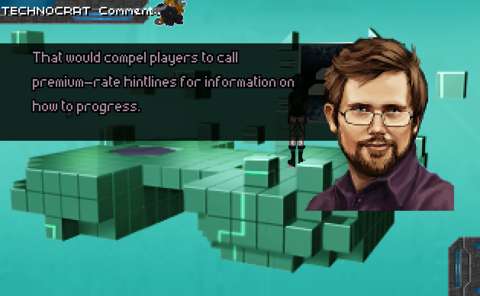
DEUS EX MACHINA:
For better or worse, there are many moments in Technobabylon when sci-fi technology comes to the fore to save the day, or otherwise had been instrumental in solutions for a sticky situation.
One example happens as early as the first scene. The automated door of Latha’s apartment just so happens to have digital security measures which work on other appliances in the apartment too. Of course, there can be the argument that electronic products of a sci-fi future can be this versatile.
Another example is this game’s take on nanotechnology, “wetware”; there will be many occasions when wetware conveniently provides tools and substances to achieve something concerning the human body. Of course, there is the argument that “wetware” is supposed to do just that, and there is considerable exposition on its many applications prior to such scenes.
There are occasions when an unbelievable occurrence is not so easy to rationalize. One example is a turret conveniently running out of ammo after taking down an unwitting person, thus allowing the player character to tamper with it without risk.
SOME PIXEL-HUNTS:
The game’s artist tries his best to make sure that items which are important to solutions have visual designs which make them distinct from other objects in the scene. Yet, skilled as he is, he cannot catch every flaw.
One of these flaws is pixel-hunting, which is the ages-old fuss of trying to find a script-trigger location which is represented by only a few pixels on-screen. In Technobabylon, this can be encountered when there is an object with multiple context-sensitive locations.
For example, there is a scenario in which Latha is detained in a “waiting room” at CEL headquarters. One of the steps which she has to take in order to escape is to pull a table around; this has to be done by placing the mouse cursor on one of the two sides of the table.
In more competently designed adventure games, this is performed via a drop-down menu. Of course, Technobabylon lacks this.
This gap in the UI design is contrasted further by the implementation of a custom-made cursor tooltip for a later chapter, apparently for the purpose of speeding up the gameplay of that chapter. Since the developer could implement this, it can seem odd that he could not implement a drop-down menu for the cursor.
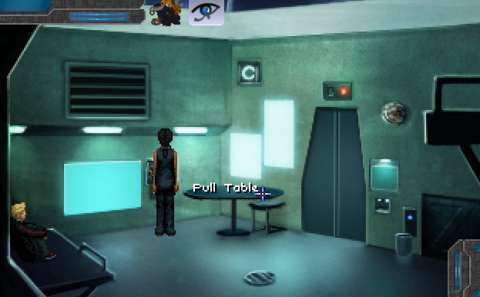
REFLEX MINI-GAMES:
For better or worse, there are two moments in the game in which the player has to enact the solution to a problem in real-time.
The first of these is more straight-forward than the other: the player has to use moving cover to stay out of sight of an armed enemy and get to a location. The second requires the player to consider the delays in the animations of the player character before the character can land a hit on an incoming projectile.
Although such mini-games are not unheard of in adventure games, their inclusion is not unanimously welcome, especially by people who have the opinion that they have no place in games where solutions should come from reasoning and logic.
Fortunately, the developer realizes this and has implemented feedback mechanisms which make the mini-games progressively easier with each failure on the player’s part. This is appreciable if the player is really terrible and wants to hurry things along, but to other players, this might seem cheesy and makes these segments seem more unwarranted.
VISUAL DESIGNS:
Like other Wadjet Eye games, Technobabylon utilizes pixel art. There are three components to the artwork: foreground and background, the immediate environment, and the sprites for characters.
The foreground and background are the most striking parts of the visuals, but they are also the most static. It is not clear whether they were drawn pixel by pixel, or that they are digital paintings which have been strained through filters. Nevertheless, they look quite good (for pixelated art), as can be seen in the first screenshot.
The immediate environment is where most ambient animations occur. The player is also expected to interact with objects in the immediate environment too. For this purpose, most of these objects may have the aforementioned animations, or they are drawn such that they noticeably contrast against everything else, as had been mentioned earlier.
For better or worse, Wadjet Eye has decided to maintain the visual designs of character sprites in adventure games of yore as a tradition of sorts. This means that “human-looking” characters can sometimes look oddly proportioned, such as having bigger mouths than they should when they talk. Of course, this should arguably not be an issue; there are plenty of other contemporary games which make use of ‘retro’ visuals and (presumably) human characters with body shapes that are even more bizarre.
On the other hand, these other games have their characters lavishly animated (or at least appearing to be convincingly so). Technobabylon’s characters (and those if earlier Wadjet Eye games for that matter) have stiff animations. This lack of animations makes the game’s visuals seem antiquated, whereas those other games look refreshing in comparison.
There are at least some smoother visuals to be seen in the Trance. In fact, most of the characters which appear in the Trance look noticeably different from each other. Latha’s avatar, Mandala, looks much like a French anime character, for example. The Trance avatars of some other characters even look out of place, like they belong in a Flash game instead of a game that has been made with Adventure Game Studio.
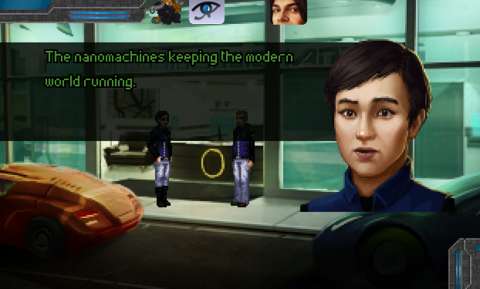
SOUND DESIGNS:
The visuals may be limited by Wadjet Eye’s design traditions, but the audio is not.
First and foremost is the music, composed by Nathan Allen Pinard, who apparently owns the copyright to the soundtracks too. The soundtracks are not all memorable, but they often match the mood of the current situation.
Almost all characters are voiced. Some of the voice-overs are provided by veterans of Wadjet Eye titles over the years, including those who have provided voice-overs for Blackwell Epiphany. Some of the voice talents happen to be recently recruited, such as the one for Latha Sesame. Fortunately, the delivery of all the voice-overs are adequate; incidentally, Wadjet Eye happens to be using a dedicated recording studio, according to the developer commentary.
As for sound effects, most of these are for the purpose of ambiance. For example, there are many places where there is moving machinery, so it is understandable that there are noises for such things. (Amusingly, the composer does mention that these noises have been composed using sound clips which are not produced by moving machinery at all.)
WRITING:
The writing is the most worthwhile element of the game. This can be seen in the descriptions of objects when they are examined; there is often dry humour to be had in these. The voice-overs also happen to benefit from the writing too; the remarks which the characters make go a long way to express their personalities.
There are also many references to earlier Wadjet Eye games. For example, there is a character whose voice actress has worked on the Blackwell Epiphany titles. In one dialogue scene, this character mentions that she has changed over the years through having a few epiphanies.
COMMENTARY:
The player can enable developer commentary at any time during a playthrough. Every time the player moves into a location, there are icons which appear at the top edge of the screen; the player can click on these to have the developers reveal the reasoning (or lack thereof) behind their design decisions.
The developer commentary reveals the very different personalities of the people who worked on the game. There is Nathan Allen Pinard, a self-proclaimed loner with considerable knowledge of acoustics. There is Ben Chandler, who sounds like the most rational of the lot, despite being the artist who worked on some disturbing scenes. There is Dave Gilbert, who often remarks on how thankful and guilty he feels about his “executive meddling”. Finally, there is James Dearden, the lead developer who sometimes has an oddball sense of humour.
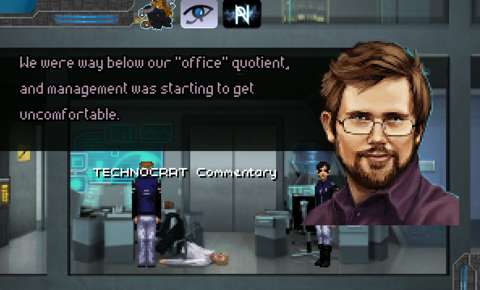
SUMMARY:
Technobabylon has some problems; some of these are perennial issues in point-and-click adventure games, such as pixel-hunts, whereas others are due to Wadjet Eye’s traditions, such as the stiffly animated characters. Nevertheless, the game’s writing and developer commentaries compensate enough for its shortfalls such that playing it is far from a waste of time.

